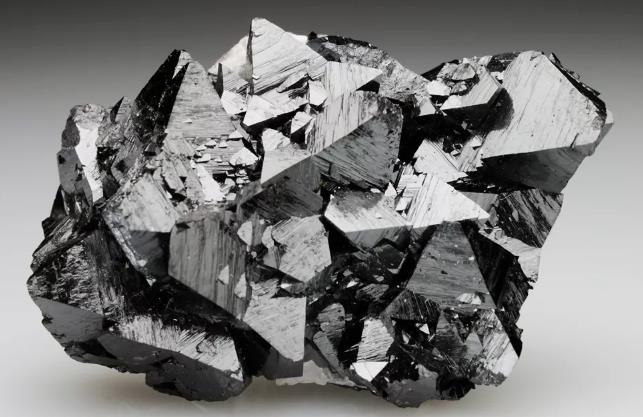
15311826613
Click to add WeChatManganese is a Group VIIB element in the fourth period of the periodic table of elements. In nature, manganese has II, III, IV and VII valence states, among which II and IV valence states are common manganese valence states. Manganese oxidizes very easily in air. Under heating conditions, powdered manganese can be combined with chlorine, bromine, phosphorus, sulfur, silicon and carbon elements.

Manganese has a strong lithophile nature in the earth’s lithosphere and silicate-phase meteorites, but it has a strong oxygen affinity in the upper part of the lithosphere. Properties: Although manganese and iron have many similar chemical properties in the lithosphere and meteorites, manganese is not siderophilic.
Manganese ore can usually be decomposed by acids. Commonly used acids include hydrochloric acid, nitric acid-hydrogen peroxide, hydrofluoric acid-sulfuric acid, and phosphoric acid-nitric acid. Mineral samples that are not decomposed by acid can be melted and decomposed with alkaline flux or acidic flux. When pyrolusite is heated to 550~600℃, it decomposes and turns into β-brownite (Mn2O3).
Most manganese ores contain a lot of water, especially dried manganese ores, which are highly water-absorbent. Manganese ore generally contains impurities such as silica, phosphorus, lead, sulfur, aluminum, arsenic, barium, calcium, magnesium, potassium and sodium, and is sometimes accompanied by copper and cobalt in manganese ore layers. , nickelandother rare metals, among which silica, sulfur, phosphorus and arsenic are harmful impurities. In particular, the phosphorus content is very important and is an important indicator for evaluating manganese ores. . Some of them contain calcium oxide and magnesium oxide, which are beneficial components during smelting.
Manganese is widely distributed in nature. Manganese is contained in almost all kinds of ores and silicate rocks. The most common types of manganese ore are anhydrous and hydrous manganese oxide and manganese carbonate. There are 150 kinds of manganese minerals currently known, but they contain high manganese and can be concentrated in large quantities to form There are only 5-6 types of manganese minerals with economic value. Among them, the important and economically valuable ones are pyrolusite and duromanganite. There are also hydromanganese ore, brown manganese ore, Black manganese ore, rhodochrosite, etc. The manganese content in these minerals can reach about 50-70%, and they are important industrial minerals of manganese.
Tetragonal crystal system, the crystals are fine columnar or needle-shaped, usually in the form of lumps or powders body. Color and streaks are black. The luster and hardness vary depending on the crystal thickness and shape. Those with good crystallization will have a semi-metallic luster and higher hardness, while those with cryptocrystalline blocks and powders will have a dull luster, low hardness, and can easily stain hands.Specific Gravity Around 5. Pyrolusite is mainly formed by sedimentation and is one of the main components of sedimentary manganese ore. In the oxidation zone part of the manganese deposit, all primary low-price manganese minerals can also be oxidized into pyrolusite. Pyrolusite is a very common mineral in manganese ore and an important mineral raw material for manganese refining.
Monoclinic crystal system, crystals are rare, usually in the form of stalactite, kidney-shaped and grape-shaped aggregates , also in the form of dense blocks and dendrites. The color and stripes are black, semi-metallic luster, hardness 4~6, specific gravity 4.4~4.7. Duronite is mainly of exogenous origin and is found in the oxidation zone of manganese deposits and sedimentary manganese deposits. It is also a very common manganese mineral in manganese ores and an important mineral raw material for manganese smelting.
Monoclinic crystal system, the crystal is columnar, with vertical stripes on the columnar surface. Crystal clusters are often produced in the geodes of some manganese-containing hydrothermal veins. In sedimentary manganese deposits, they are mostly cryptocrystalline blocks, or oolitic, stalactite-like aggregates, etc. The color of the mineral is black, the stripes are brown, semi-metallic luster, hardness 3~4, specific gravity 4.2~4.3 >. Hydromanganite is found both in some hydrothermal deposits of endogenous origin and in sedimentary manganese deposits of exogenous origin. It is one of the mineral raw materials for manganese refining.
Tetragonal crystal system, the crystal is a tetragonal bipyramid, usually a granular aggregate. Color is black, stripes are brown-orange or reddish-brown, semi-metallic luster, hardness 5.5, specific gravity 4.84. Black manganese ore is formed by endogenesis or metamorphism. It is found in some contact metasomatic deposits, hydrothermal deposits and sedimentary metamorphic manganese deposits. It is symbiotic with brown manganese ore and is also one of the mineral raw materials for manganese smelting.
Tetragonal crystal system, the crystals are bipyramidal, and are also produced in granular and massive aggregates. The mineral is black, with brownish-black streaks, semi-metallic luster, hardness 6, and specific gravity 4.7~5.0. Other characteristics are the same as black manganese ore.
Trigonal crystal system, the crystal is rhombohedral, usually granular, massive or nodular. The mineral is rose-colored, easily oxidized and turned into brown-black, with glassy luster, hardness 3.5~4.5, specific gravity 3.6~3.7. Rhodochrosite formed by endogenous processes is more common in some hydrothermal deposits and contact metasomatic deposits; rhodochrosite formed by exogenous processes is widely distributed in sedimentary manganese deposits. Rhodochrosite is an important mineral raw material for manganese refining.
Isometric crystal system, common single shapes include cube, octahedron, rhombohedral dodecahedron, etc., and the aggregate is granular or massive. The color ranges from steel gray to iron black, turning to brown after weathering, with dark green streaks and semi-metallic luster. Hardness is 3.5 to 4, and specific gravity is 3.9 to 4.1. Manganese sulfur ore is abundant in sedimentary metamorphic manganese deposits and is one of the mineral raw materials for manganese refining.
*The content of this article comes from the Internet
*The pictures come from the Internet
* If the material content involves copyright and other issues, please contact the person in charge of this website in time
*The content of this website is for reference only and does not constitute direct suggestions for readers to make decisions